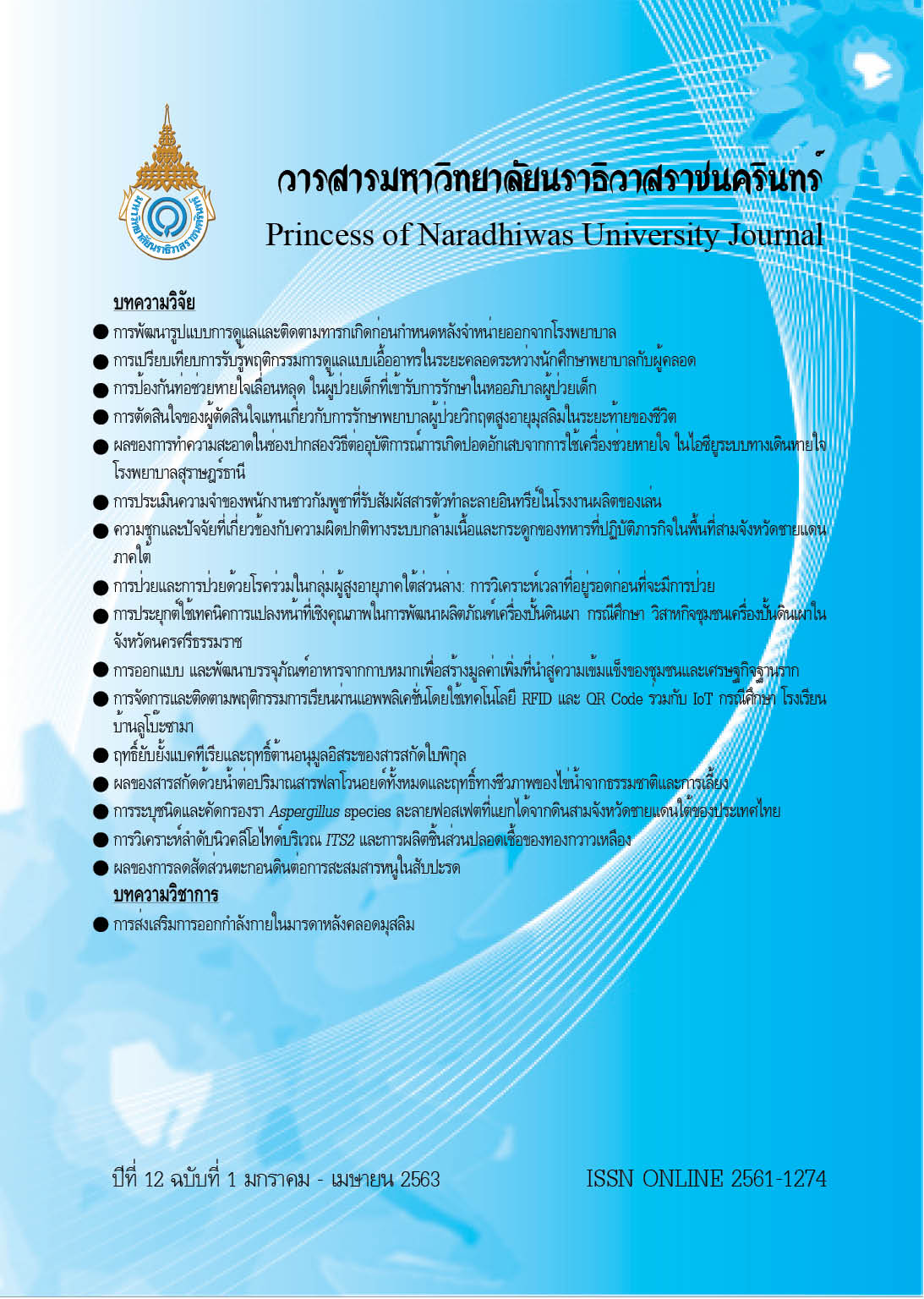Antibacterial and Antioxidant Capacities of Tanjong (Mimusops elengi L.) Leaf Extract
Keywords:
Tanjong, Mimusops elengi L., Antibacterial Activity, Phytochemical, AntioxidantAbstract
The objective of this research was to study antibacterial activity, phytochemical. The objective of this research was to study antibacterial activity, phytochemical screening, and antioxidant activityof Tanjong leaf extract. Antibacterial activity was determined by agar well diffusion method. The result showed that Tanjong leaf extract exhibited against gram positive bacteria such as Bacillis cereus ATCC 11778, Micrococcus luteus TISTR884, as well as the methicillin-resistant Staphylococcus aureus 142 (MRSA142) andStaphylococcus aureus TISTR517 with the inhibition zone 21.7, 21.3, 29.0 and 21.8 mm, respectively. However, gram negative bacteria were resistant to Tanjong leaf extract. The MIC value of the Tanjong leaf extract gave 9.38 mg/ml with B. cereus ATCC 11778 and MIC value were given equally: 18.75 mg/ml with M. luteus TISTR884, MRSA142 and S. aureus TISTR517. The MBC value to inhibit B. cereus ATCC 11778, M. luteus TISTR884andS. aureus TISTR517 were 300 mg/ml and MBC value for MRSA142 was 600 mg/ml. Phytochemical screening test showed that Tanjong leaf extract contained flavonoids, phenols, and saponins.The Tanjong leaf extract showed antioxidant activity at 3.2 µg ascorbic acid/g fresh weights and the IC50 at 23.35 µg/ml. Moreover, the total flavonoid content was 0.8 mg Quercetin/g fresh weights and phenolic content was 0.72 mg gallic acid/ g fresh weights.
References
Aziz, A.F.A., & Iqbal, M. (2013). Antioxidant activity and phytochemical composition of Cynometracauliflora.
Journal of Experimental and Integrative Medicine, 3(4), 337-341.
Barreira, J. C., Ferreira, I. C., Oliveira, M. B., & Pereira, J. A. (2010). Antioxidant potential of chestnut (Castanea
sativa L.) and almond (Prunus dulcis L.) by-products. Food Science and Technology International,16(3), 209-16.
Dewanto, V., Wu, X., Adom, K. K., & Liu, R. H. (2002). Thermal processing enhances the nutritional value of tomatoes by increasing total antioxidant activity. Journal of Agricultural and Food Chemistry,8(10), 3010-4.
Frieri, M., Kumarb, K., & Boutinc, A. (2017). Antibiotic resistance. Journal of Infection and Public Health,10, 369-378.
Gadamsetty, G., Maru, S., & Sarada, N.C. (2013). Antioxidant and anti-inflammatory activities of the methanolic leaf extract of traditionally used medicinal plant Mimusops elengi L. Journal of Pharmaceutical and Reserch, 5(6), 125-130.
Ganesh, G., Abhishek, T., Saurabh, M.,& Sarada, N.C. (2014). Cytotoxic and apoptosis induction potential of Mimusops elengi L. in human cervical cancer (SiHa) cell line. Journal of King Saud University - Science, 26, 333–337.
Gill, A. O., & Holley, R. A. (2006). Disruption of Escherichia coli, Listeria monocytogenes and Lactobacillus sakeicellular membranes by plant oil aromatics. International Journal of Food Microbiology, 106, 1-9.
Ikram, E.H.K., Eng, K.H., Jalil, A.M.M., Ismail, A., Idris, S., & Azlan, A. (2009). Antioxidant capacity and total phenolic content of Malaysian underutilized fruits. Journal of Food Composition and Analysis, 22(5), 388-393.
Indrawattana, N., & Vanaporn,Muthita. (2015). Nosocomial infection. Journal of Medicine and Health Sciences,
(1), 81-92.
Murugan, N. B., Mishra, B. K., & Paul. B. (2018). Antioxidant and antibacterial evaluation of medicinal plants used in the starter culture (Wanti) of fermented rice beverage in West Garo hills, Meghalaya. Journal of Pharmacognosy and Phytochemistry, 7(1), 1669-1674.
Mostafa, A.A., Al-Askar, A.A., Almaary, K.S., Dawoud, T.M., Sholkamy, E.N.,& Bakri M.M. (2017). Antimicrobial activity of some plant extracts against bacterial strains causing food poisoning diseases. Saudi Journal of Biological Sciences, 25(2), 361-366
On-Anong, S., Gornganok, P., Kolip, P & Charuwan, D. (2019). Antibacterial and Antioxidant Activity of Nam-Nam Fruit. Extract, 11(2), 156-167.
Radji, M., Agustama, R.A., Elya, B.,& Tjampakasari, C.R. (2013). Antimicrobial activity of green tea extract against isolates of methicillin-resistant Staphylococcus aureus and multi-drug resistant Pseudomonas aeruginosa. Asian Pacific Journal of Tropical Biomedicine, 3, 663-667.
Saritha, K., Rajesh, A., Manjulatha, K., Setty, O.H.,&Yenugu, S. (2015). Mechanism of antibacterial action of the alcoholic extracts of Hemidesmusindicus (L.) R. Br. ex Schult, Leucasaspera (Wild.), Plumbagozeylanica L., and Tridaxprocumbens (L.) R. Br. ex Schult. Frontiers in Microbiology, 6, 577.
Sehgal, S., Gupta, V., Gupta, R., &Saraf, S.A. (2011). Analgesic and antipyretic activity of Mimusops elengi L. (bakul) leaves. Pharmacologyonline, 3, 1-6.
Shan, B., Cai, Y-Z., Brooks, J.D., & Corke, H. (2007).The in vitro antibacterial activity of dietary spice and medicinal herb extracts. International Journal of Food Microbiology, 117, 112-119.
Tantipaibulvut, S., Nuamsetti, T., & Dechayuenyong, P. (2012). Antibacterial Activity of Some Fruit-Peel Extracts. KKU Research Journal, 17(6), 880-894.
Tiwari, B. K., Valdramidi, V. P., O’Donnell, C. P., Muthukumarappan, K., Bourke, P., & Cullen, P. J. (2009). Application of natural antimicrobials for food preservation. Journal of Agricultural and Food Chemistry, 57, 5987-6000.
Valle Jr, D. L., Andrade, J. I., Puzon, J. J. M., Cabrera, E. C., & Rivera, W. L. (2015). Antibacterial activities of ethanol extracts of Philippine medicinal plants against multidrug-resistant bacteria. Asian Pacific Journal of Tropical Biomedicine, 5(7), 532-540.




